Article
Diffusion’s 2018 Direct-to-Consumer Purchase Intent Index

From clothes and toothbrushes to travel luggage, mattresses and couches, the new Direct to Consumer movement is in full swing. That’s why at Diffusion we decided to take a look at how consumers are actually reacting to this influx of new retail offerings in our 2018 Direct-to-Consumer Purchase Intent Index. According to the report, a whopping one-third of Americans will make 40 percent of their purchases from D2C brands within the next five years. And even further, 81 percent of Americans claim they’ll make at least one purchase from D2C brands within the next five years. Let’s take a look at the three findings that D2C brands need to understand to transfer today’s success into a long lasting venture.
Why do we love the toothbrush sent directly to our home each month, so much?
Direct to consumer brands are exploding and have even more potential than we think as they continue to encroach into every part of consumer life. So, what is it that really entices consumers about these brands? Is it being able to have something as large as a couch conveniently shipped to our front door in three simple boxes? Or is it the promise of a 100-night trial that gives us the freedom to change our mind? According to the 2018 Direct-to-Consumer Purchase Intent index, it’s all of these things.
The key factors that are driving American D2C brand purchase intent are convenience and product quality. In fact, more than one in four (27%) Americans who will purchase D2C products in the next five years will do so because of greater convenience than going to a traditional store. And even further, 1 in six (18%) will do so because they perceive D2C quality to be better than that of traditional brands.
How to make what we love better
While D2C brands are taking the industry by storm they’re still not outpacing traditional brands in all aspects, especially when it comes to the customer service department. Less than 10 percent of Americans say the customer service from D2C brands is superior to that of traditional brands and, only 11 percent feel D2C brands offer more personalization or assistance in the buying process than their traditional rivals.
Since legacy brands have the historical experience needed to truly excel within customer relations, it makes sense that the new kids on the block might have ground to make up. As D2C brands continue to tout their customer relations as key differentiators, Americans aren’t yet having it. But, there is a clear opportunity for these brands to really impress American consumers by taking note from their legacy brand rivals.
The key to connecting with consumers
While many D2C brands are born online, it doesn’t mean that consumers have given up on the tradition of a physical store presence. We’ve seen these brands continue to open physical store fronts as they become more successful – like Diffusion client Burrow who opened their first store in SOHO this September. These initiatives bode well for brands and consumers alike, as they provide brands the opportunity to connect on a deeper level with their consumer and provide consumers the shopping medium they crave.
If you’re interested in checking out the full findings from the Diffusion 2018 Direct-to-Consumer Purchase Intent Index, click here to request your copy.
eMarketer: eMarketer Coverage of Diffusion PR D2C Purchase Intent Index
O’Dwyer’s: O’Dwyer’s Coverage of Diffusion PR D2C Purchase Intent Index
Retail Dive: Retail Dive Coverage of Diffusion PR D2C Purchase Intent Index
Holmes Report: Holmes Report Coverage of Diffusion PR D2C Purchase Intent Index
Retail TouchPoints: As DTC Sales Rise, Retailers Should Leverage Smart Promotions and Instant Gratification





